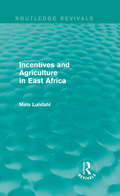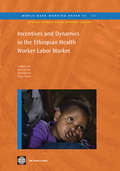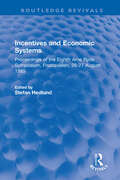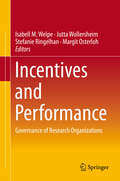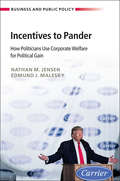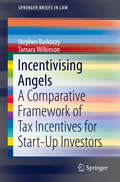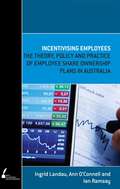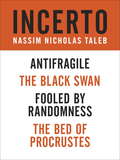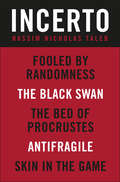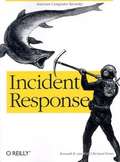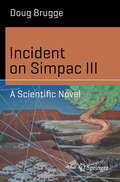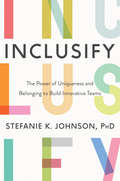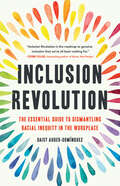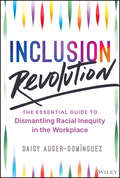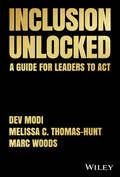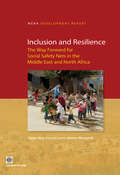- Table View
- List View
Incentives and Agriculture in East Africa (Routledge Revivals)
by Mats LundahlAgriculture is at the centre of the economies of many developing countries, and its stagnation and poor performance across large parts of Africa is a major cause for concern. First published in 1990, this book focuses on the nature and role of incentives in agricultural organization and production in East Africa, looking in particular at the political and ideological determinants of that role. Mats Lundahl analyses ways of improving agricultural performance, and considers the ‘African socialism’ of Julius Nyerere in contrast with the market-led approaches, which he favours. A detailed title, this volume will of interest to all those concerned with the issues of rural development, including students of development studies, economics, and African studies.
Incentives and Dynamics in the Ethiopian Health Worker Labor Market
by Agnes Soucat William Jack Joost De Laat Kara HansonBy international standards, health workers in Ethiopia are in short supply. In addition, those who do enter the health fields and remain in the country disproportionately live and work in the capital, Addis Ababa. This paper uses detailed data gathered from nearly 1,000 health workers to examine the incentives and constraints that health workers face when choosing where to work, the likely responses of workers to alternative incentive packages, and the longer term performance of the health worker labor market. This working paper was produced as part of the World Bank's Africa Region Health Systems for Outcomes (HSO) Program. The Program, funded by the World Bank, the Government of Norway, the Government of the United Kingdom and the Global Alliance for Vaccines and Immunization (GAVI), focuses on strengthening health systems in Africa to reach the poor and achieve tangible results related to Health, Nutrition and Population. The main pillars and focus of the program center on knowledge and capacity building related to Human Resources for Health, Health Financing, Pharmaceuticals, Governance and Service Delivery, and Infrastructure and ICT.
Incentives and Economic Systems: Proceedings of the Eighth Arne Ryde Symposium, Frostavallen, 26-27 August 1985 (Routledge Revivals)
by Stefan HedlundFirst published in 1987, Incentives and Economic Systems is a selection of papers presented at the Eighth Arne Ryde Symposium at Frostavallen, Sweden on how institutions attempt to guide individual behaviour by manipulating the social and economic incentive system. These economic and social aspects of incentives determine ‘rational’ and ‘irrational’ behaviour by individuals and organizations across various economic systems. The essays in the volume deal with various aspects of the incentive problems and the various manifestations of such problems, along with moral and ethical issues. The essays will be an enlightening read for students of economics, policymaking and international politics.
Incentives and Institutions: The Transition to a Market Economy in Russia
by Grigory Yavlinsky Serguey BraguinskyHere, for the first time, two of Russia's leading economists provide an authoritative analysis of the transition to a democratic market economy that has taken place in Russia since 1990. Serguey Braguinsky, a Russian economist with extensive international experience, and Grigory Yavlinsky, leader of the liberal "Yabloko" party and a major public figure in Russia, focus on the institutions that are critical to a successful transition and the economic incentives needed to make these institutions work. Finally, they discuss in detail the specific components of the economic processes that are necessary for economic transition in general and they draw lessons that can be applied to other nations dealing with similar transitions. In 1989, Grigory Yavlinsky became a member of the Commission for Economic Reform and wrote the groundbreaking "500 Day Plan," which outlined the first program of transition to a market economy. Two years later, he co-wrote the program of strategic cooperation between the Soviet government and the West (known as the "Grand Bargain"). Here he and Serguey Braguinsky examine what went wrong with the Russian plan--and what is needed to put the economy back on the road to becoming a fully functioning market economy. The first section of the book presents a new interpretation of the political economy of the socialist state and the incentives and institutions that underpin it, with an emphasis on the present Russian situation. The second part deals with the political economy of "spontaneous transition" and the inefficiencies inherent in economies that lack the organizations and institutions that inhere in established Western democratic economies. In the final section, the authors present a program of actions to put the economic transition in Russia back on track, based on their assessment of the actual current state of both the economy and the government. Their approach is unique in emphasizing organizational evolution at the microeconomic level instead of stressing macroeconomic issues such as money and inflation that are at the heart of most arguments. This is a thoughtful and thought-provoking book and one that will be widely discussed and debated.
Incentives and Performance
by Isabell M. Welpe Jutta Wollersheim Stefanie Ringelhan Margit OsterlohThis book contributes to the current discussion in society, politics and higher education on innovation capacity and the financial and non-financial incentives for researchers. The expert contributions in the book deal with implementation of incentive systems at higher education institutions in order to foster innovation. On the other hand, the book also discusses the extent to which governance structures from economy can be transferred to universities and how scientific performance can be measured and evaluated. This book is essential for decision-makers in knowledge-intensive organizations and higher-educational institutions dealing with the topic of performance management.
Incentives at the Bangladesh Rural Advancement Committee (BRAC)
by Nava Ashraf Kristin JohnsonIndustry and Background Note
Incentives for Innovation in China: Building an Innovative Economy (Routledge Contemporary China Series)
by Jun Li Xuedong DingIn the past three decades, China has successfully transformed itself from an extremely poor economy to the world’s second largest economy. The country’s phenomenal economic growth has been sustained primarily by its rapid and continuous industrialization. Currently industry accounts for nearly two-fifths of China’s gross domestic product, and since 2009 China has been the world’s largest exporter of manufactured products. This book explores the question of how far this industrial growth has been the product of government policies. It discusses how government policies and their priorities have developed and evolved, examines how industrial policies are linked to policies in other areas, such as trade, technology and regional development, and assesses how new policy initiatives are encouraging China’s increasing success in new technology-intensive industries. It also demonstrates how China’s industrial policies are linked to development of industrial clusters and regions.
Incentives in the NFL (Abridged)
by Brian J. Hall Andrew Wasynczuk Jonathan P. Lim Sara Del Nido Katherine DowdIndustry and Background Note
Incentives to Pander: How Politicians Use Corporate Welfare for Political Gain (Business and Public Policy)
by Nathan M. Jensen Edmund MaleskyPolicies targeting individual companies for economic development incentives, such as tax holidays and abatements, are generally seen as inefficient, economically costly, and distortionary. Despite this evidence, politicians still choose to use these policies to claim credit for attracting investment. Thus, while fiscal incentives are economically inefficient, they pose an effective pandering strategy for politicians. <P><P>Using original surveys of voters in the United States, Canada and the United Kingdom as well as data on incentive use by politicians in the US, Vietnam and Russia, this book provides compelling evidence for the use of fiscal incentives for political gain and shows how such pandering appears to be associated with growing economic inequality. As national and subnational governments surrender valuable tax revenue to attract businesses in the vain hope of long-term economic growth, they are left with fiscal shortfalls that have been filled through regressive sales taxes, police fines and penalties, and cuts to public education.<P> Provides rigorous empirical analysis, involving cutting-edge methods including: survey and natural experiments, regression discontinuity designs, and matching estimators. These techniques will give sophisticated readers confidence in the argument and policy conclusions; Includes a chapter on comparative incentive programs and an analysis of Vietnam and Russia that broadens the reach of the study beyond western democracies to authoritarian political systems.<P> Vivid description and unique presentation of the analysis will benefit readers familiar with well-known case studies such as Ferguson Electric, Google in Lenoir North Carolina, and the Kansas City border wars.<P>
Incentivising Angels: A Comparative Framework of Tax Incentives for Start-Up Investors (SpringerBriefs in Law)
by Stephen Barkoczy Tamara WilkinsonThis book examines tax incentives for investors in start-up companies through a critical analysis of Australia’s early-stage investors (ESI) program, and a comparison of that program with the United Kingdom’s Seed Enterprise Investment Scheme (SEIS) upon which it is loosely modelled. It discusses the importance of innovation and the special role that venture capital plays in supporting start-ups, and explains the policy rationale for introducing the ESI program as well as dissecting its technical requirements in detail. Special attention is devoted to the program’s ‘early stage’ and ‘innovation’ requirements, which are crucial for determining whether a start-up qualifies for the tax incentives. The book is the first in-depth scholarly legal analysis of the ESI program and the first occasion it has been compared and contrasted with a foreign program. The comparative discussion of the ESI program with the SEIS program enables the authors to make suggestions for reforms to the ESI program so that it can better achieve its policy objectives. The fact that the book includes reform suggestions makes it particularly interesting for policy makers. It is also of broad relevance to legal and finance scholars and students as well as entrepreneurs, angels, venture capitalists and their advisors.
Incentivising Employees: The theory, policy and practice of employee share ownership plans in Australia
by Ann O'Connell Ian Ramsay Ingrid LandauEmployee share ownership has the potential to generate a culture of enterprise and innovation, and build national wealth and savings. This book is the culmination of a multi-year research project funded by the Australian Research Council and represents the first detailed discussion of the theory, policy and practice of employee share ownership plans (ESOPs) in Australia. The topics examined in the book are key legal and policy issues relevant to ESOPs, the current incidence and forms of ESOPs in Australia, the corporate law and taxation law frameworks, why employers implement ESOPs and why employees participate in them, international comparisons, and recommendations for reform.
Incentivized Development in China
by David J. BulmanChina's economy, as a whole, has developed rapidly over the past 35 years, and yet its richest county is over 100 times richer in per capita terms than its poorest county. To explain this vast variation in development, David J. Bulman investigates the political foundations of local economic growth in China, focusing on the institutional and economic roles of county-level leaders and the career incentives that shape their behaviour. Through a close examination of six counties complemented by unique nation-wide data, he presents and explores two related questions: what is the role of County Party Secretaries in determining local governance and growth outcomes? And why do County Party Secretaries emphasize particular developmental priorities? Suitable for scholars of political economy, development economics, and comparative politics, this original study analyzes the relationship between political institutions, local governance, and leadership roles within Chinese government to explain the growing divergence in economic development between counties.
Incept LLC and Confluent Surgical (A)
by James Weber Toby Stuart Bhaskar ChakravortiA venture capitalist must decide whether to invest in a medical technology company that licenses intellectual property from a privately held IP holding company based on a platform technology. Entrepreneurs Amar Sawhney and Fred Khosravi founded Incept LLC to commercialize their multi-use hydrogel technology. The pair then spun off Confluent Surgical to develop some, but not all, of Incept's IP. The specifics of which IP Confluent would develop were described by a licensing agreement between Incept and Confluent. Venture capitalist Charles Warden of Schroder Ventures Life Sciences was deciding whether to invest in a Series A financing round in Confluent. Initially very excited about the deal, Warden becomes concerned about Confluent's valuation and its ability to succeed as a business when he learns about restrictions placed upon Confluent by the licensing agreement. The case describes Incept's business model and its approach to managing risk in early stage ventures. The case also addresses issues such as diversification and options preservation as well as the importance of trust and long-term relationships in decision-making in entrepreneurial arenas.
Incerto 4-Book Bundle: Fooled by Randomness, The Black Swan, The Bed of Procrustes, Antifragile (Incerto)
by Nassim Nicholas TalebNassim Nicholas Taleb's landmark Incerto series is an investigation of luck, uncertainty, probability, opacity, human error, risk, disorder, and decision-making in a world we don't understand, in nonoverlapping and standalone books. All four volumes--Antifragile, The Black Swan, Fooled by Randomness, and the special expanded edition of The Bed of Procrustes, updated with more than 50 percent new material--are now together in one ebook bundle. ANTIFRAGILE "Startling . . . richly crammed with insights, stories, fine phrases and intriguing asides."--The Wall Street Journal Just as human bones get stronger when subjected to stress and tension, many things in life benefit from disorder, volatility, and turmoil. What Taleb has identified and calls "antifragile" is that category of things that not only gain from chaos but need it in order to survive and flourish. The resilient resists shocks and stays the same; the antifragile gets better and better. What is crucial is that the antifragile loves errors, as it incurs small harm and large benefits from them. Spanning politics, urban planning, war, personal finance, economic systems, and medicine in an interdisciplinary and erudite style, Antifragile is a blueprint for living in a Black Swan world. THE BLACK SWAN "The Black Swan changed my view of how the world works."--Daniel Kahneman, Nobel laureate A black swan is a highly improbable event with three principal characteristics: It is unpredictable; it carries a massive impact; and, after the fact, we concoct an explanation that makes it appear less random and more predictable. The astonishing success of Google was a black swan; so was 9/11. In this groundbreaking and prophetic book, Taleb shows that black swan events underlie almost everything about our world, from the rise of religions to events in our own personal lives, and yet we--especially the experts--are blind to them. FOOLED BY RANDOMNESS "[Fooled by Randomness] is to conventional Wall Street wisdom approximately what Martin Luther's ninety-five theses were to the Catholic Church."--Malcolm Gladwell, The New Yorker Are we capable of distinguishing the fortunate charlatan from the genuine visionary? Must we always try to uncover nonexistent messages in random events? Fooled by Randomness is about luck: more precisely, about how we perceive luck in our personal and professional experiences. Set against the backdrop of the most conspicuous forum in which luck is mistaken for skill--the markets--Fooled by Randomness is an irreverent, eye-opening, and endlessly entertaining exploration of one of the least understood forces in our lives. THE BED OF PROCRUSTES "Taleb's crystalline nuggets of thought stand alone like esoteric poems."--Financial Times This collection of aphorisms and meditations expresses Taleb's major ideas in ways you least expect. The Bed of Procrustes takes its title from Greek mythology: the story of a man who made his visitors fit his bed to perfection by either stretching them or cutting their limbs. With a rare combination of pointed wit and potent wisdom, Taleb plows through human illusions, contrasting the classical views of courage, elegance, and erudition against the modern diseases of nerdiness, philistinism, and phoniness.
Incerto 5-Book Bundle: Fooled by Randomness, The Black Swan, The Bed of Procrustes, Antifragile, Skin in the Game (Incerto)
by Nassim Nicholas TalebThe landmark five-book series—all together in one ebook bundleThe Incerto is an investigation of opacity, luck, uncertainty, probability, human error, risk, and decision making when we don&’t understand the world, expressed in the form of a personal essay with autobiographical sections, stories, parables, and philosophical, historical, and scientific discussions, in non-overlapping volumes that can be accessed in any order. The main thread is that while there is inordinate uncertainty about what is going on, there is great certainty as to what one should do about it.This ebook bundle includes:FOOLED BY RANDOMNESSTHE BLACK SWANTHE BED OF PROCRUSTESANTIFRAGILESKIN IN THE GAME
Incident Management for Operations
by Chris Hawley Rob Schnepp Ron VidalAre you satisfied with the way your company responds to IT incidents? How prepared is your response team to handle critical, time-sensitive events such as service disruptions and security breaches? IT professionals looking for effective response models have successfully adopted the Incident Management System (IMS) used by firefighters throughout the US. This practical book shows you how to apply the same response methodology to your own IT operation.You’ll learn how IMS best practices for leading people and managing time apply directly to IT incidents where the stakes are high and outcomes are uncertain. This book provides use cases of some of the largest (and smallest) IT operations teams in the world. There is a better way to respond. You just found it.Assess your IT incident response with the PROCESS programmatic evaluation toolGet an overview of the IMS all-hazard, all-risk frameworkUnderstand the responsibilities of the Incident CommanderForm a unified command structure for events that affect multiple business unitsSystematically evaluate what broke and how the incident team responded
Incident Response
by Richard Forno Kenneth R. van WykAre you ready for a computer "incident," such as a security breach? Incident Responseshows you both the technical and administrative aspects of building an effective incident response plan. You'll learn about the different types of incidents and ways to respond to them, how to put together an incident response team, what procedures to use, what tools there are for investigating incidents, and where to find extensive online resources.
Incident on Simpac III: A Scientific Novel (Science and Fiction)
by Doug BruggeA few hundred years into the future, a wave of space colonization follows a disastrous earlier attempt to inhabit nearby extrasolar planets. It is guided by a new computational method based on massive data-driven socio-cultural and socio-epidemiological modeling and using novel biological computers, fed with data on Earth’s history of successes and failures. Yet, in the newly settled Simpac system, some unexpected and worrying anomalies begin cropping up, making an urgent expedition to the system necessary: is it the underlying data, the computations, or is some unknown entity tampering with the space colonization program? A race against time ensues as the lives of four strangers begin to converge. While grounded in the social systems aspect, the author posits that the future is likely to be characterized by more biology-based tools than most contemporary science fiction – which most often relies entirely on non-biological hardware in terms of advanced technologies – predicts. The result is an entertaining and skillful blend of thriller and SF, complemented by a nontechnical appendix describing the underlying science.
Incidental Trainer: A Reference Guide for Training Design, Development, and Delivery
by Margaret Wan"We have trained and trained. The employees still don't get it!" Although a critical component in improving organizational performance, training is usually not conducted effectively and results in a waste of resources. Often, subject-matter experts are given training responsibilities because of their technical expertise; however, just as often, the
Inclusify: The Power of Uniqueness and Belonging to Build Innovative Teams
by Stefanie K. JohnsonIn this groundbreaking guide, a management expert outlines the transformative leadership skill of tomorrow—one that can make it possible to build truly diverse and inclusive teams which value employees’ need to belong while being themselves. Humans have two basic desires: to stand out and to fit in. Companies respond by creating groups that tend to the extreme—where everyone fits in and no one stands out, or where everyone stands out and no one fits in. How do we find that happy medium where workers can demonstrate their individuality while also feeling they belong?The answer, according to Stefanie Johnson, is to Inclusify. In this essential handbook, she explains what it means to Inclusify and how it can be used to strengthen any business. Inclusifying—unlike “diversifying” or “including”— implies a continuous, sustained effort towards helping diverse teams feel engaged, empowered, accepted, and valued. It’s no use having diversity if everyone feels like an outsider, she contends.In her research, Johnson found common problems leaders exhibit which frustrate their attempts to create diverse and cohesive teams. Leaders that underestimated the importance of group coherence and dynamics often have employees who do not feel like they belong; leaders that ignore the benefits of listening to different perspectives leave some people feeling like they cannot be their authentic selves.By contrast, leaders who Inclusify can forge strong relationships with their teams, inspire greater productivity from all of their workers, and create a more positive environment for everyone. Having a true range of different voices is good for the bottom line—it allows for the development of the best, most innovative, and creative solutions that are essential to success. Inclusify reveals the unexpected ways that well-intentioned leaders undermine their teams, explains how to recognize the myths and misperceptions that drive these behaviors, and provides practical strategies to become an Inclusifyer. By learning why uniqueness and belonging are so imperative, leaders can better understand what makes their employees tick and find ways to encourage them to be themselves while ensuring they feel like they are fully part of the group. The result is a fully engaged team filled with diverse perspectives—the key to creating innovative and imaginative ideas that drive value.
Inclusion Breakthrough: Unleashing the Real Power of Diversity
by Judith H. Katz Frederick A. MillerConstant, continuing, and cataclysmic change is causing a major crisis within business organizations today. Faced with constantly advancing technology, unpredictable market shifts, intense global competition, and an increasingly independent "free agent" workforce, the only way for an organization to adapt and succeed is to build a "culture of inclusion" that nurtures and draws on the talents of a diverse workforce. Easy to say but hard to do; most organizations are mired in industrial revolution, static-world business models administered by monocultural, bordering-on-oppressive, "command and control" hierarchies. Organizations at risk include Fortune 500 giants, entrepreneurial start-ups, manufacturing and retail operations, government agencies, not-for-profits, educational institutions, and others. Most organizational change efforts-whether labeled as diversity efforts, re-engineering, right-sizing, or total-quality-management-are a waste of time, money, and human effort. Most produce more cynicism than results, and they can poison the waters for future change efforts. The Inclusion Breakthrough cuts a path through this potential minefield, offering a proven methodology for strategic organizational change, including models for diagnosing, planning, and implementing inclusion-focused, culture-change strategies tailored to each organization's individual needs. It also describes the key competencies for leading and sustaining a culture of inclusion. Offering real-world results of "before and after" surveys, including anecdotal and statistical reports of organizational change achieved using the methodologies described, The Inclusion Breakthrough presents an overview of current workplace conditions, attitudes, and policies based on interviews, surveys, and focus groups encompassing thousands of people in major organizations. The Inclusion Breakthrough demonstrates why the bottom line must be the central focus of any change strategy-and more importantly, how to carry that strategy out successfully.
Inclusion Revolution: The Essential Guide to Dismantling Racial Inequity in the Workplace
by Daisy Auger-DomínguezA leading diversity executive offers step-by-step guidance for confronting racial bias in the workplace We are in the midst of a global reckoning on race, and corporations are on high alert. But conventional approaches have fallen short, leaving nagging questions about next steps. Why do diversity trainings fail? What&’s so wrong with a company&’s &“colorblind&” workplace culture? In Inclusion Revolution, Daisy Auger-Domínguez provides frank answers to why popular efforts fail. She then presents the definitive roadmap for revolution, through her dynamic step-by-step process: Reflect, Visualize, Act, and Persist. She offers proven, research-based strategies for racially inclusive management. Racial inequality in the workplace is a problem we can solve. Inclusion Revolution offers the necessary tools for managers to address issues of race, power, and exclusion, to build change that lasts. Because through the best teams, companies can finally create a stronger future.
Inclusion Revolution: The Essential Guide to Dismantling Racial Inequity in the Workplace
by Daisy Auger-DomínguezTackle racial bias and discrimination at your company and create a representative and diverse leadership team In Inclusion Revolution: The Essential Guide to Dismantling Racial Inequity in the Workplace, workplace strategist and C-suite executive Daisy Auger-Domínguez delivers a timely, inspirational, and practical exploration of why mainstream efforts at diversity improvement tend to fail and what you can do today to successfully create a diverse and representative leadership team at your company. In the book, the author explains her four-step process of reflection, visualization, action, and persistence, and walks you through how to use research-based strategies to promote diversity. This hands-on toolkit for leaders and people professionals will show you how to: Achieve the benefits—including higher revenues and more satisfied employees—enjoyed by high-performing, diverse companies Fruitfully address the complex and fraught issues of race, power, and exclusion at your firm Transform the seemingly intractable problems of racial bias and discrimination into realistically solvable issues you can begin to address immediately Perfect for managers, directors, executives, entrepreneurs, founders, and other business leaders, Inclusion Revolution is also a must-read for people officers and human resources professionals at companies of any size and in any industry.
Inclusion Unlocked: A Guide for Leaders to Act
by Marc Woods Dev Modi Melissa C. Thomas-HuntInclusion Unlocked is the definitive guide for business leaders to unlock the power of diversity and enable inclusion to flourish in their organisations In Inclusion Unlocked a team of accomplished leadership experts deliver an insightful set of solutions to the obstacles that block progress and prevent leaders from delivering on the diversity results their employees, customers and investors demand. Written by authors whose core areas of expertise are inclusion and diversity, this book will provide an Inclusive Leader Scorecard model, access to an online diagnostic tool, and proven strategies that enable greater belonging. As well as this, Inclusion Unlocked provides first-hand accounts of how well-known CEOs, Chief People Officers and Chief Diversity Officers have accelerated progress in their diversity initiatives, and the pitfalls they have learnt to avoid. The authors explain how business leaders can act as a driving force for change if they use the right mindset and tools. You’ll also discover: How to understand the relevance of inclusive leadership to impressive business growth How to identify the key levers for change and progress by cutting through the complexity Strategies that enable greater belonging, psychological safety, and innovationAn indispensable resource for business leaders, HR and DEI practitioners who want a practical and easy to follow guide for advancement in diversity initiatives. Inclusion Unlocked is the inclusion toolkit needed to make significant progress.
Inclusion and Resilience
by Victoria Levin Matteo Morgandi Joana SilvaThe report aims to meet two broad objectives: (a) enhance knowledge about the current state of existing social safety nets (SSNs) and assess their effectiveness in responding to new and emerging challenges to the poor and vulnerable in the region by bringing together new evidence, data, and country-specific analysis; and (b) open up and inform a debate on feasible policy options to make SSNs in the Middle East and North Africa more effective and innovative. The first chapter, 'a framework for SSN reform,' describes and illustrates the reasons for the region's growing need for SSN reform and establishes the framework for renewed SSNs. It identifies key goals for SSNs (promoting social inclusion, livelihood, and resilience) and illustrates how these goals have been achieved in some parts of the region and elsewhere. The second chapter, 'key challenges that call for renewed SSNs,' analyzes the challenges facing the region's poor and vulnerable households, which SSNs could focus on as a priority. Two large groups are at higher-than-average poverty risk: children and those who live in rural or lagging areas. The third chapter, 'the current state of SSNs in the Middle East and North Africa,' analyzes SSN spending and assesses different aspects of the SSN systems' performance. The fourth chapter, 'the political economy of SSN reforms in the Middle East and North Africa: what do citizens want?' presents new evidence on citizens' preferences concerning redistribution and SSN design, using newly collected data. It also discusses how political economy considerations could be taken into account in designing renewed SSNs in the region. The fifth chapter, 'the way forward: how to make safety nets in the Middle East and North Africa more effective and innovative,' proposes an agenda for reform and the path for moving forward, using global experience and the evidence presented in the preceding chapters.
